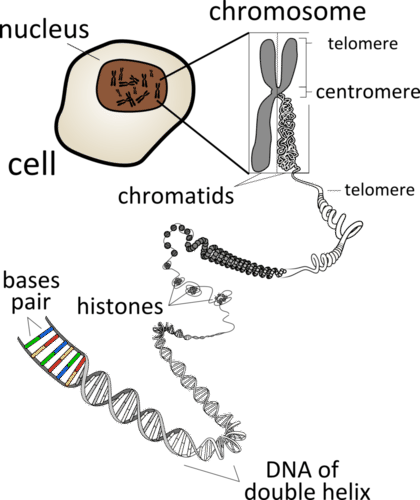Abstract

In 1888, W. Waldeyer coined the term “chromosome”.
Chromosomes are thread-like cell structures found in the nucleus of cells. Each of these chromosomes comprises proteins and a single molecule of deoxyribonucleic acid (DNA). These are the unique instructions fundamentally obtained from the parents, which are passed onto the offspring.
These structures of chromosomes are involved in tightly enclosing the DNA around proteins referred to as histones. In the absence of packaging, the molecules of DNA would be extremely long to be contained within the cells.
In order for an organism to properly develop, grow and function, cells must undergo division, constantly producing new cells to substitute old cells. At the time of cell division, it is necessary for DNA to stay intact and distributed evenly among cells. Chromosomes ensure DNA is copied accurately and distributed in the huge distribution of cell divisions, yet there are mistakes occurring while copying at rare events. It is vital that reproductive cells (sperm and egg cells) comprise the accurate number of chromosomes and the exact structure.
Chromosome Number
The chromosome number is different for a particular species. It describes the ploidy or number of sets of chromosomes found in the cells of different living entities. The chromosome number in asexually producing species is the same always while in sexually reproducing organisims, the number of chromosomes in the somatic cells of the body is diploid, while in sex cells, it is haploid. This haploid number is as a result of the process of meiosis taking place.
The entities having multiple diploid numbers of chromosomes are polyploids. Among several plant groups, polyploids are a normal evolutionary tactic, rarely seen in animals. Some of the examples of polyploid plants and animals are African clawed frogs, potatoes etc. In most animals, the changes from the typical chromosome number for a species could come with some changes, drastic at times, in the entities. For example, if a foetus in humans is under the influence of polyploidy, it is usually aborted very early on in pregnancy.
Types of Chromosome Number
There are two types of chromosome numbers:
- Somatic chromosome number (2n) – Chromosomes that are not sex chromosomes are somatic. They appear in sets or pairs in the cells of the body; however, as single chromosomes in spermatozoa.
- Gametic chromosome number (n) – Chromosomes found in haploid cells are gametic, particularly an ovum or spermatozoon. These are in contrast to that seen in diploid cells or somatic cells.
Chromosome Number of Different Organisms – List
Given below are chromosome numbers of different organisms.
|
Number of chromosomes in humans |
|
Maize chromosome number |
|
Onion chromosome number |
|
Down syndrome chromosome number |
|
Rice chromosome number |
Role of Chromosomes
Chromosomes are involved in the following activities:
- Provision of genetic information for the cellular functions of an entity
- Ensures exact distribution of DNA to the daughter nuclei at the time of cell division
- Protection of the genetic material at the time of cell division from any potential damage
Related terms:
Chromatid: These are one of the two distinguishable longitudinal subunits of chromosomes. They are of two sister chromatids and two non-sister chromatids.
Centromere: In the chromosomes, the localised regions with which spindle fibres attach are referred to as primary constrictions or centromeres.
These are typically not seen exactly at the centre of the chromosome, and in some cases, these can be seen at the end of the chromosomes. The regions present on either side of the centromeres are called arms of chromosomes.
These structures enable the chromosomes to align properly at the time of complicated processes of cell division. When the chromosomes are copied in preparation to produce new cells, the centromeres function as attachment regions for the two halves of each of the replicated chromosomes – sister chromatids.
Telomeres: These are repetitive stretches of DNA seen at the two terminals of the linear chromosomes. They are highly stable and do not unite with the telomeres of other chromosomes. These are involved in protecting the ends of chromosomes.
The telomeres in many types of cells lose some of their DNA every time cell division occurs. As a result, gradually, when all the telomere DNA goes, the cells cannot further replicate and die.
Secondary constriction: In addition to primary constriction, some of the chromosomes show secondary constriction as well. The chromosomal area between telomeres is referred to as trabant or satellite. The chromosomes having secondary constitutions are referred to as satellite chromosomes or Sat-chromosomes.
The secondary constriction is seen in the short arms near one terminal or in several chromosomes, which are seen in the long arms adjacent to the centromere.
Satellite chromosomes: The chromosome which has a satellite is referred to as a satellite chromosome.
Chromomere: These are small bead-like structures, serially aligned, found in the chromosomes of some species. In chromosomes, the structure of chromosomes is constant. These structures are also referred to as idiomeres and result from the local coiling of a continuous DNA thread.
Karyotype: It is the process of ordering and pairing all the chromosomes of an entity; hence it renders the genome-wide image of the chromosomes of an individual.
For related articles, visit BYJU’S NEET.
More here:
Comments